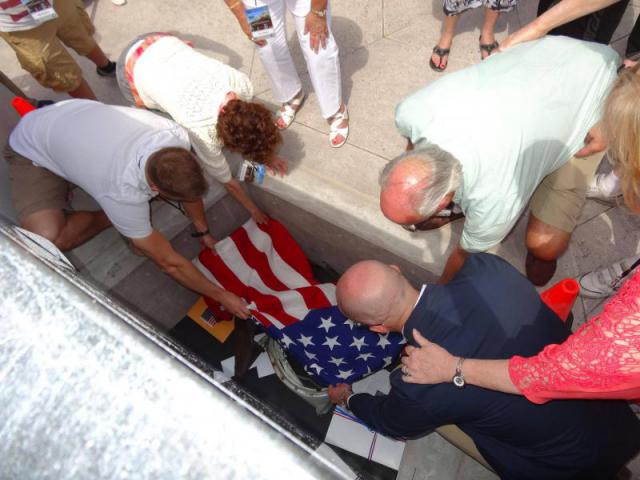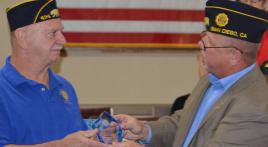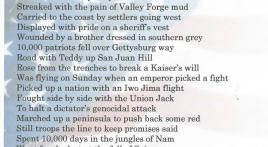Photo courtesy of Silent Heroes of the Cold War Memorial Facebook page | Relatives of the Air Force servicemembers and scientists who died in the USAF 9068 plane crash lower a flag into a vault at the Silent Heroes of the Cold War Memorial on Mt. Charleston outside Las Vegas.
The nation's first memorial devoted solely to the "silent heroes" of the Cold War, including veterans and intelligence agents, was dedicated May 29 on Mt. Charleston, in the Spring Mountains National Recreation Area just outside Las Vegas.
The Silent Heroes of the Cold War Memorial is also the first national memorial in Nevada.
The memorial pays special honor to 14 men who died in a plane crash near Mt. Charleston's peak. These 14 men lost their lives in service of their country, and were nearly lost to history, until civilian Steve Ririe turned his obsession into a mission to identify and honor them.
Ririe, a Las Vegas native, said he remembers hiking Mt. Charleston as a boy.
"It's quite a hike," he said. "And near the very peak of Mt. Charleston, which is just shy of 12,000 feet, is this plane crash."
He learned that no one knew who had been in the plane or what the plane had been doing. But the hike itself was enjoyable, and when he faced a personal crisis in 1998, he decided to return to Mt. Charleston to regroup.
Decades later, he again faced the debris.
"I reminisced that when I was a young boy it was a really cool thing to see. It's like, 'Wow, a plane crashed!' You don't have any maturity really. . . . Yet, it was a completely different experience as an adult, and sitting up there and realizing that this is not a survivable incident, and no one knew what it was.
"And the truth is I never intended to do anything beyond that point. I was going to go on with my life."
But on the mountaintop, Ririe said he was moved to act. He said, he knew he wasn't alone. Once he returned home, he began waking daily between 3 and 3:30 a.m.
"The thought I had was: I had to find out who was on that plane," Ririe said.
He began a series of investigations that led him from the Air Force to the National Archives to the Central Intelligence Agency. Two years after beginning his search, Ririe learned the information about the plane crash had been declassified--oddly enough--in September 1998, the same time he had been reflecting atop Mt. Charleston.
"I read the names of the men and thought, 'There’s those people that I had to find,' " he said.
The men included five Air Force servicemembers: George Pappas, Jr.; Paul Winham; Clayton Farris; Guy Fasolas and John Gaines. Five members of the CIA were aboard--James Bray, Terence O'Donnell, James Brown, Edwin Urolatis and William Marr. The rest of the casualties were civilians, employees of Lockheed or Hycon, and included Harold Silent, Fred Hanks, Rodney Kreimendahl and Richard Hruda.
In November 1955, they had been flying on USAF 9068 - a C-54 airplane - from Burbank, Calif., to Area 51 to work on the U2 spy plane. USAF 9068 had crashed on Mt. Charleston, not quite scaling its peak.
"These people are part of that secret army that kept the nukes from flying," Ririe said.
Ririe's searching didn't stop. He and a woman who'd read about the project in a newspaper article, Marian Kennedy, sought the families of the deceased.
"It took several years, but we found every family," he said. "But what I discovered was something I was just not prepared for, because the plane crash happened before I was even born. . . . I ran into people that had not had closure, people that had suffered terribly and were never told the truth, never told the story of what happened."
Ririe said he was put in the position of explaining how their loved ones perished--a story that had been a secret even to their spouses.
"It was such a strange phone call for them that oftentimes they wouldn't even know how to react. They would just listen, and there'd be this awkward silence. The first few kind of took me back — I didn't even know how to react myself but then I kind of understood from the first few calls what they were going through, so I helped them out," he said. "It was more just explaining, 'Well, I know this is strange, I know this is a phone call that you probably never thought you would ever get. But I had the accident report and it details what happens to your father....'
"There were a few family members who could not reopen it in their life. There's just a couple of them but they just said it’s too painful, I can’t go back there. But most of them, most of them went through this thing again, where it was almost like they had lost their dad again."
He said this reopening caused mothers - long silent on the subject - to share details, scraps of what was known, with their now-adult children. One said men had shown up at her house and told her to keep quiet, warning her of surveillance. Another was too afraid to attend her husband's funeral. So not only had many of these families lost the financial breadwinner, Ririe said, but ". . . it's almost like, for the family members, their husbands just disappeared and nothing was said. Like they never existed."
Through the Boy Scout troop Ririe led, he got in touch with state Sen. Ray Rawson, who decided a memorial of some sort should be built. He charged Ririe with the task.
Over the course of years, momentum built, and Sen. Harry Reid embraced the project, sending it to Congress, making the site a national memorial. Pres. Barack Obama signed the resolution.
Waylaid by work on a recreational area also on top of the mountain, Ririe said it could sometimes feel as though the memorial was in "a holding pattern."
Legionnaire Michael L. Emerson, an expert on building veterans monuments, reached out and offered a helping hand. Ririe said Emerson served as a consultant on the project, guiding him through fundraising and red tape. Emerson also served on the memorial committee.
Emerson, deemed "The Monument Man" by the Legion Magazine, facilitated funding the project through the American Legion's post in Henderson.
"The American Legion shepherding the funds and being a part of what we're doing just gave it more gravitas, or more legitimacy to what we were trying to accomplish," Emerson said.
But ultimately, Ririe said he's proud this was largely a civilian-led effort. Veterans shouldn't have to build their own monuments, he said.
"It's kind of like Christmas and every year when Christmas comes you have to buy your own gift. So where's the appreciation of those that are the beneficiary of what you've done?" he said.
Over 16 years after Ririe's hike and almost 60 years since the crash, the memorial was dedicated and opened.
The monument to the 14 who died in USAF 9068 is a large boulder with the plane's mangled propeller affixed to the front.
The Cold War memorial includes secrets Ririe said he hopes draw young people in, such as an untranslated Latin phrase (he wants them to Google it), a quote from Pres. John Kennedy and the names of those who died in USAF 9068. In part, the memorial reads: "Our peace and prosperity will always depend on the bravery of unsung Americans willing to make the ultimate sacrifice without recognition."
Nearby, a vault holds personal items from the family members of the plane crash victims as well as the debris from the wreckage.
At the dedication ceremony, the flag presented at Brown's funeral was raised over the memorial. The families of the honored deceased lowered the flag and laid over the items in the vault. They placed white roses on top. The vault was then sealed.
"Hearing the stories of these families, they almost felt as though they never got to bury their loved one. . . . The idea was: This is not a time capsule, this is synonymous with burying, with a gravesite for them."
He said that this memorial will hopefully shield the intelligence community from negative portrayals - as "power-hungry" spies on TV.
"There's this secret army out there: They don't live in the ignorance bubble. They're constantly anticipating our threats, things that we don't even know about and they need tools and yet they often are devalued by a public that just doesn't understand. . . . I hope this memorial will help in a small way," Ririe said.
For more about the Silent Heroes of the Cold War Memorial, visit the website: http://coldwarmonument.org/
For more on Emerson, read the story here: http://www.legion.org/magazine/214899/monument-man





